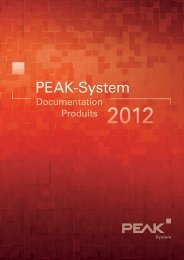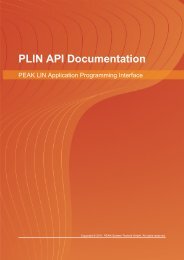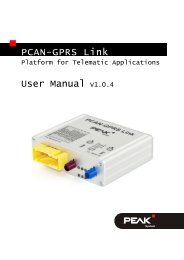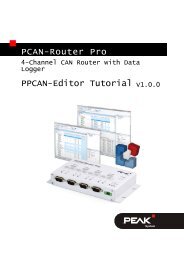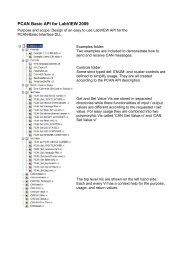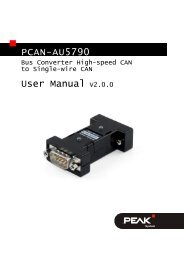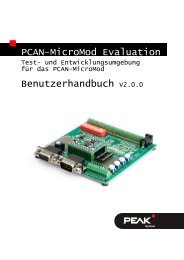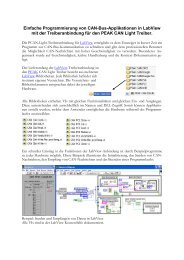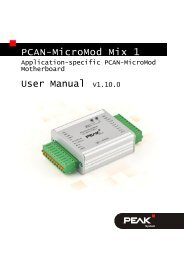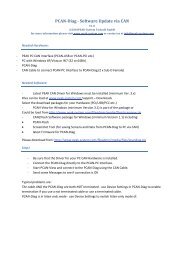PCAN-driver for Linux - PEAK-System
PCAN-driver for Linux - PEAK-System
PCAN-driver for Linux - PEAK-System
You also want an ePaper? Increase the reach of your titles
YUMPU automatically turns print PDFs into web optimized ePapers that Google loves.
“cat /proc/interrupts“<br />
“cat /proc/ioports“<br />
“cat /proc/iomem“<br />
„cat /proc/pci“ or „cat /proc/bus/pci/devices“ depending on the kernel version.<br />
„cat /proc/bus/usb/devices“<br />
Please note that the interrupts of the hardware aren't registered until its use.<br />
To diagnose USB there are also programs with a graphical user interface like e.g.<br />
„USBView“.<br />
With garbled installations sometimes paths <strong>for</strong> translation of the <strong>driver</strong> are set wrong.<br />
That's why while translating the <strong>driver</strong> a message like this appears:<br />
*** Host machine kernel version=2.4.18-4GB, Driver kernel version=2.6.5, \<br />
Path to kernel sources=/mnt/usr/src/linux, use KBUILD=yes<br />
With this message it is possible to compare if the <strong>driver</strong> is really translated <strong>for</strong> the used<br />
kernel. The „KBUILD“ mechanism is used from kernel 2.6.x on.<br />
Q. How do I interpret the output of “cat /proc/pcan“ ?<br />
A. The second line gives in<strong>for</strong>mation about the release of the <strong>driver</strong>. In the third line the<br />
number of the found CAN-channels and the assigned major-number are shown. From<br />
line four on the characteristics of the each CAN-channel are described.<br />
The first column shows the minor-number assignment of the channel, the second<br />
column shows the type of the channel, the third and fourth column the assignment to<br />
base addresses (ports) and interrupt-numbers. The following four columns count the<br />
number of processed read-, write-, interrupt- and errors transactions. The last column<br />
shows the last occurred error status of the channel. The status is a bit-field with an<br />
interpretation like this table:<br />
Bit Description<br />
0 Chip-send-buffer full<br />
1 Chip-receive-buffer overrun<br />
2 BUS warning<br />
3 BUS passive<br />
4 BUS Off<br />
5 Receive-buffer is empty<br />
6 Receive-buffer overrun<br />
7 Send-buffer is full<br />
14 Illegal parameter<br />
Both columns „base“ and „ir“ are misused with USB channel types. „base“ is showing<br />
the serial number of the module and „ir“ the programmed device number of the module.<br />
The column „irqs“ in case of type 'usb' counts the number of received or sent USBpackages..<br />
Q. What happens if I plug out the interface while using <strong>PCAN</strong>-USB?<br />
<strong>PCAN</strong>-<strong>driver</strong> <strong>for</strong> <strong>Linux</strong> page 18 of 23



![English - Low Quality [7.2 MB] - PEAK-System](https://img.yumpu.com/5931738/1/184x260/english-low-quality-72-mb-peak-system.jpg?quality=85)
